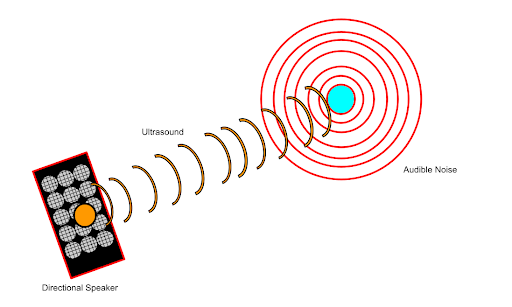Most commercial speakers work in a simple, basic way. When you plug in an auxiliary cord or connect to it via BlueTooth, the speaker plays the audio– which then radiates from the speaker into people’s ears.
However, there exists a different, less conventional way of creating sound– a different type of speaker– that plays audio in ways that seem almost unreal.
Directional Speakers
This other way of making sound is typically called a directional— or more technically “parametric”— speaker. This special speaker produces audio at whatever it’s pointed at, so that sound appears to come from the speaker’s target and not the speaker itself.
The directional speaker produces specific high-frequency sounds— sounds that humans cannot hear— that travel in a straight line. These sounds, upon hitting a wall or other solid object, collapse into normal, audible audio. Depending on the intended use of the speaker, the range at which a directional speaker works can vary from a few feet to several miles.
Like the water inside a water balloon someone has just thrown at a wall, sound travels in a straight line from the speaker until it hits the wall and “splashes” everywhere.
You cannot hear, or be “splashed” by, the sound this speaker makes until it hits something, allowing others to hear it.
The water balloon metaphor is not an accurate scientific description of how this technology works. If you’re interested in learning more about how this speaker works technically, check out the websites of directional speaker companies like Holosonics and Focusonics, as well as ExplainThatStuff’s explanation of how directional speakers work.
Uses & Applications
Directional speakers have a wide variety of applications in large, open spaces.
Museums can use directional speakers to beam quiet, low-volume sounds into people’s ears in front of open museum exhibits, allowing one person to stand in front of an exhibit and hear a vocal description of it while another can walk by in complete silence. This way of using these speakers– creating low-volume sounds– is also useful for libraries and other public installations that want to give auditory information to visitors without disturbing others.
With directional speakers, megaphones and loudspeakers can be much more direct and clear to a large audience than traditional speakers.
If a presenter or police officer was able to use a directional megaphone to speak to an audience, they could point the sound into the audience so that the speaker produces the sound from within the audience, making it easier to hear and understand.
This same concept also applies to the loudspeakers in large, echoey spaces like the Leesville gym. If Leesville installed these speakers in the main gym, sounds could be less echoey and clearer to the audience— allowing for more cohesive communication during sports games and assemblies.
Additionally, Leesville could enhance its theater with this technology: a collection of directional speakers, aimed at the middle and back of the auditorium, could allow people sitting in the middle or back to hear sounds as if they were right next to the stage. Alternatively, a performance could point the speakers to the right or left of the audience to create more vivid sound effects during action scenes.
If you had a directional speaker or two, you could set up some interesting devices for yourself.
If you took two directional speakers and set them up on your computer desk, you could have audio beamed to both sides of your ears like headphones– letting you privately hear sound without actually having to wear anything.
Additionally, a directional speaker could be a fun toy, letting you make any noise you wish appear from seemingly anywhere. With a directional speaker you could take a whoopee cushion joke to a whole new level— or whisper into people’s ears from afar without others being able to hear.
Obtaining A Directional Speaker
If you want a directional speaker for yourself, you can order one online. Beware, however, that directional speakers are quite costly, ranging in the hundreds of dollars. If you wish to purchase one, you may need to spend a considerable amount of money.
Additionally, since there are so few directional speakers available online compared to traditional speakers, and since many traditional speakers label and advertise themselves as “directional,” it may be hard to determine which online listings are actual, legitimate directional speakers.
In order to determine whether an online listing for a speaker is actually directional in the sense of this new technology, you can try seeing if the listing mentions the use of ultrasound in the speaker’s operation or calls itself “parametric.”
Or, if you’re more technical and know how to build electrical circuits, you could try to build one yourself.

Hi, I’m Blase. I like playing video games and running in my free time, and I have two cats.

Leave a Reply